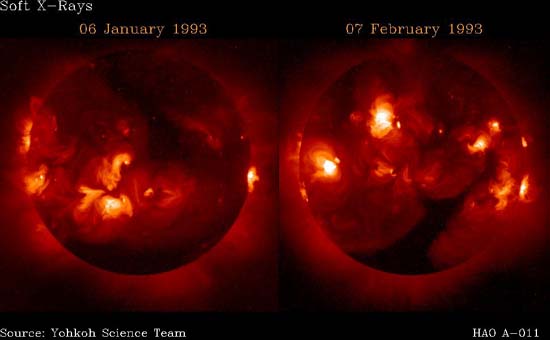
11. The Sun in X-rays
With a surface temperature of 5800 K, the Sun should normally emit
no X-rays at all, and so should look completely dark on an X-ray image.
Experience reveals that this is not the case, as demonstrated first
by X-ray telescopes onboard the Skylab space station, and
exemplified here
by two X-ray images of the Sun taken on different days with an X-ray
telescope on board the Japanese satellite Yohkoh. While large
portions are indeed dark, small, very bright regions are also quite
conspicuous. X-ray bright regions indicate heating to temperatures
in excess of 2 million degrees Kelvin. Comparisons of such images
with, for example, white
light images (see slide #1) taken simultaneously reveal that the
brightest
X-ray emitting regions are almost always overlying sunspots or active
regions. Sequences
of X-ray images occasionally reveals very sudden and short lived
increases in brightness, known as flares.
During such events, the X-ray brightness
of a flaring active region often exceeds the total X-ray brightness
of the rest of the Sun. Flares are also visible
as brightening in H![]() , and
sometimes even in white light.
They are one of the manifestations of the class of phenomena
grouped under the heading of solar activity.
The reconfiguration and dissipation of magnetic fields via
reconnection
is believed to be the energy source of solar flares.
Other noteworthy features on these images are the very dark regions
located near the south solar pole, called
coronal holes. Coronal holes are usually located above the
solar poles, but sometimes may extend down to lower latitudes, as
illustrated by these two images.
, and
sometimes even in white light.
They are one of the manifestations of the class of phenomena
grouped under the heading of solar activity.
The reconfiguration and dissipation of magnetic fields via
reconnection
is believed to be the energy source of solar flares.
Other noteworthy features on these images are the very dark regions
located near the south solar pole, called
coronal holes. Coronal holes are usually located above the
solar poles, but sometimes may extend down to lower latitudes, as
illustrated by these two images.